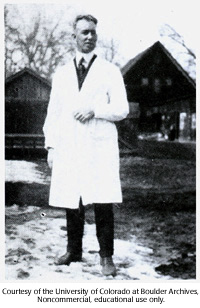
Notes for Evolution - The Triumph of an Idea - Chapter 5
Click link to return to Honors 301T
Schedule
or to History
of Life Chapter 1
Chapter 5 - Rooting the Tree of Life - From Life's Dawn to the Age of Microbes
Objectives:
a) Contrast the "three domains" breakdown of living organisms with the older "5 Kingdoms" approach.
b) Understand the significance of the discovery that some RNA molecules can "self splice"
c) Compare a traditional branching tree view of evolution with a "mangrove" view of life, involving frequent horizontal gene transfers, especially involving microbial organisms.
d) Appreciate the role that duplications of entire genes might have in evolution, as opposed to simpler point mutations.
e) Gain an overview of the substantial evidence supporting an "endosymbiosis" origin of mitochondria and plastids in eukaryotes.
Introduction

Featured Tree: The "Big Tree"open the above tree in new window here. )
Source of image: Pace, N.R. 1997 (note; original source no longer available; somewhat updated tree here in pdf format)
I. Introduction
RQ Ev-5.1: Why does the caption (p. 101) for the figure on p. 100 thank the bacterial partners of plants for providing us with the air we need to breathe?
II. The Tree of Life
Key Terms: evolutionary tree, microbes, enzyme (ribozyme)
RQ Ev-5.2: Scientists used to think that all organisms that were not eukaryotes were "prokaryotes" but more recently have changed that view. Describe how this view has changed and characterize the evidence on which the "new tree of life" is based.
III. In Search of Life's Origins
Key Terms: enzyme (ribozyme in the case of RNAs)
RNA Links: 1 - 2 - 3 - 4 - 5 - 6 - 7 - 8
 Featured
Scientist: Thomas
Cech
Featured
Scientist: Thomas
Cech
Cech and Ribozyme Links: 1 - 2 - 3 - 4 - 5
RQ Ev-5.3: Why has RNA assumed an increasing importance in theories concerning the origin of life?
IV. The Mangrove of Life
Horizontal (or Lateral) Gene Transfer Links: 1 - 2 - 3 - 4 - 5 - 6
RQ Ev-5.4: Part of what Zimmer characterizes as the "mangrove of life" has to do with the base of the "new revised tree of life," which has not a single "root" (as in the tree on p. 102) but instead has multiple interconnections between early life forms. What is the evidence that microbes sometimes obtain genes from other microbes, rather than progressively diverging from each other across their entire genome?
V. Evolution on Double Time
Key Terms: gene duplication, gene families, orthology vs. paralogy (not introduced by Zimmer but very important concepts related to gene duplication; see also: 1- 2 - 3 - 4)
RQ Ev-5.5: Why might gene duplications speed up the rate that organisms might evolve?
VI. Fusion Evolution
 Featured
Scientist: Ivan Emanuel Wallin (1883-1969)
Featured
Scientist: Ivan Emanuel Wallin (1883-1969)
source
of image
Serial Endosymbiosis Theory (SET) Links: 1 - 2 - 3 - 4 - 5 - 6
RQ Ev-5.6: The other part of Zimmer's "mangrove of life" has to do with the serial endosymbiosis theory, involving the mitochondria found in most eukaryotes and also plastids (e.g., chloroplasts) found in many eukaryotes. What is the evidence supporting this theory?
Click link to return to Honors 301T Schedule
or to History
of Life Chapter 1
This page created 2/3/03 © D.J. Eernisse, Last Modified 2/16/05, Links Last Completely Checked 3/17/03